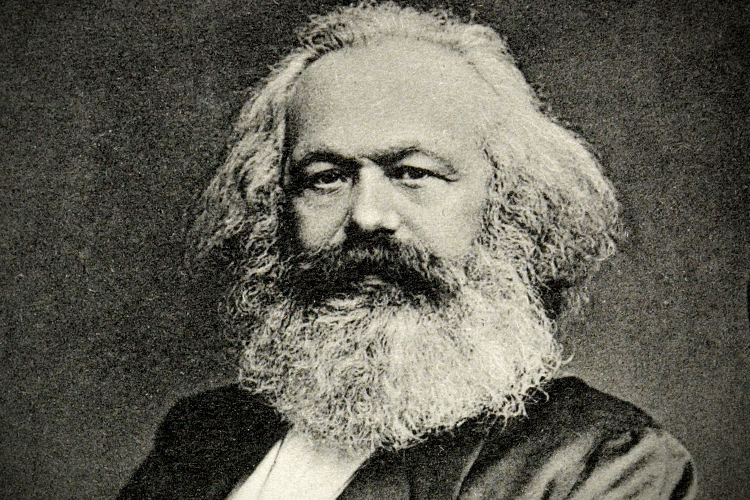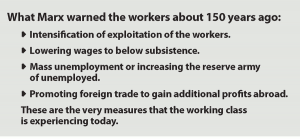

Karl Marx, nacido el 5 de mayo de 1818, explicó las contradicciones intrínsecas del capitalismo y por qué la clase obrera tenía que librarse de ese sistema de explotación.


The underlying concern was that since the so-called “recovery” began in 2009, the global economy has been in a steady state of slow growth and stagnation.
The International Monetary Fund issued warnings about so-called “emerging markets.” China had its slowest growth in 10 years. Russia is in a recession. Brazil’s growth has slowed to a crawl. Investors are starting to pull their money out of many countries.
The U.S. capitalist economy is growing anemically, while Japan and Europe are stagnating at best. The Greek debt crisis is coming to a head as the IMF and the European bankers try to force further austerity on Greece’s Syriza government. Worries about a Greek default, which could destabilize the eurozone, haunted the G-20 meeting.
Behind this condition of slow growth and stagnation is capitalist overproduction. This is the underlying malady behind the gloom at the G-20, although no one will say it — mostly because they don’t know it.
Working class and capitalist economic ‘growth’
Why should workers be concerned about the slowing rate of growth of the world capitalist economy?
“Growth” under capitalism is an increase in overall economic activity. But economic activity under the profit system is also the process of exploitation of workers. The two things are inseparable.
The aim of the capitalists is to expand their exploitation of the workers and to increase their profits. That is what growth means to them. To workers capitalist growth means more jobs. All workers must sell their labor power to a boss and enter into the relationship of exploitation in order to live. The alternative is unemployment under capitalism.
Workers get paid for only part of the time they work during the week. But they must work for the whole week. Usually they get paid just enough to stay alive while the boss gets to keep what they create during the entire week. The boss sells the product or service for money and profits from this surplus — the unpaid labor time the workers put in.
Every year tens of millions of potential workers enter the workforce around the world. If the capitalist economy does not grow fast enough to employ, that is, to exploit these new workers, as well as to employ the workers already in the workforce, then mass unemployment, part-time and temporary jobs steadily expand with population growth.
When more and more unemployed workers are seeking scarce jobs, which comes with low growth, the bosses can hire at lower and lower wages — unless the workers have a union, a good contract and are organized to defend their rights.
Karl Marx as a guide for today
This was all explained by Karl Marx over 150 years ago. He wrote for the working class and for those who wanted to organize against capitalism. His analysis is highly important for understanding what the bosses are doing today.
Here in the U.S., the capitalist class has been struggling to expand its profits of production since the global financial and economic crisis of 2007-09 ended. To be sure, speculative paper profits of bankers, hedge funds, private equity funds, Wall Street gamblers and other parasites have grown enormously in recent years. But this is largely based on the Federal Reserve Board pouring trillions of dollars of cheap money into the economy.
However, the industrial and service parts of the “real” economy have been up against world capitalist overproduction, limited markets and expanding production capabilities due to technology.
Marx explained in the third volume of his fundamental work, “Capital,” what measures the capitalists take to bolster their profits when they are facing a decline. He listed some of them in a famous chapter titled “The Law of the Tendency of the Rate of Profit to Decline.”
Here are some of the measures he outlined that tend to drive up profits:
These are the same measures that are negatively affecting the working class today.
Intensification of exploitation
Intensified exploitation means expanding the output that workers create in less and less time, often for lower wages. This is precisely what the working class is being hammered with, not only in the U.S. but around the world.
Automation on the production line, in the restaurants, hospitals, big box stores, fast food outlets is the rule today. Bar codes, computerized cash registers, robots in warehouses, centralized communications systems in stores and factories, and so on have eliminated jobs, destroyed skills and put pressure on the remaining workers to work faster.
Development of computerized efficiency programs, monitoring of workers, GPS (global positioning system) spying and directing workers in transport, Internet-based outsourcing of medical services and legal briefs, ordering and monitoring of production, automated ports, container ships, management software that can reach around the globe, and many more technologies are the modern, high-tech version of what Marx called the intensification of exploitation.
Lowering wages below subsistence
All these technologies make the skills of the workers obsolete by putting their skills into machines and software, thereby destroying jobs and skills that once paid livable wages. Millions of workers with jobs now live in poverty and need government assistance to survive. This is what Marx called lowering wages below subsistence level.
What Marx projected is now a global phenomenon. The Global Wage Report 2014/15 of the U.N.’s International Labor Organization says, “Wage growth around the world slowed in 2013 to 2.0 percent, compared to 2.2 percent in 2012, and has yet to catch up to the pre-crisis rates of about 3.0 percent.
“Even this modest growth in global wages was driven almost entirely by emerging G-20 economies, where wages increased by 6.7 percent in 2012 and 5.9 percent in 2013.
“By contrast, average wage growth in developed economies had fluctuated around 1 percent per year since 2006 and then slowed further in 2012 and 2013 to only 0.1 percent and 0.2 percent respectively.”
World ‘reserve army of unemployed’
The millions whose jobs have been eliminated through technology and speed-up now swell the “reserve army of unemployed” that Marx referred to a century and a half ago.
Again this is a global matter.
The ILO reported: “Almost 202 million people were unemployed in 2013 around the world, an increase of almost 5 million compared with the year before. This reflects the fact that employment is not expanding sufficiently fast to keep up with the growing labor force.”
The ILO further reported that in 2013, over and above the 202 million unemployed, there was an additional 62 million job gap, including 32 million new job seekers and 23 million people who became discouraged.
If current trends continue, said the ILO, and they are expected to at best, unemployment will rise by another 13 million by 2018.
It should be noted that the ILO, as an organ of the U.N., is a very conservative organization which tends to produce statistics that tone down the facts exposing world imperialism.
Unemployment in the U.S. is in the tens of millions, but the growing “reserve army of unemployed” is a permanent feature of capitalism at a dead end — the phase in which the workers are now living.
Exporting their way out of crisis
Washington and Wall Street are desperately trying to expand exports by promoting the Trans Pacific Partnership agreement, which is calculated to break open the markets of 12 countries and give corporations virtually sovereign economic power in the region. Washington is also scheming for a European Free Trade Agreement.
In general, the big imperialist countries are trying to export their way out of their crises. They want to gain a trade advantage over their rivals and engage in unequal trade with oppressed countries.
The big capitalist economies have become massively productive through technology; they all suffer high unemployment and have lowered wages. So production quickly outstrips the market for the goods produced.
But as each country tries to export its way out of the crisis in the home market, global overproduction will expand, laying the basis for new and even greater crises.
In Marx’s time, foreign imperialist investment was not a dominant factor in the world economy. That is because imperialism developed after Marx died. He would surely have included it in the capitalists’ struggle to raise profits, and it must be included today.
So workers should be deeply concerned about what the world’s financiers are saying. The big business experts cannot really predict anything very precisely, because their unplanned market system is chaotic. But it is clear that world capitalism has not revived and is not reviving. Even the pro-capitalist pundits can see this.
The working class, the labor movement, the oppressed communities, the students and youth should take the worries of the ruling class as a potential threat to the working class. When the bosses become gloomy about their economy, they are preparing to further push their crisis onto the masses.
The time to alert the workers and begin organizing a massive pushback is now.
Goldstein is the author of “Low-Wage Capitalism” and “Capitalism at a Dead End,” which can be ordered from lowwagecapitalism.org.
Boston, April 20, 2025 The leadership of the Democratic Party nationally and especially in Massachusetts…
Hamas – Islamic Resistance Movement made the following call, “Gaza cries out to you —…
The centennial of the birth of Malcolm X, also known as El-Hajj Malik El-Shabazz, is…
In a courageous act of solidarity with the Palestinian people, a Moroccan port workers’ union…
Buffalo, New York A large group of demonstrators marched on the Buffalo ICE (U.S. Immigration…
In the 1950s, when Japan and much of Europe was in ruins, the U.S. accounted…